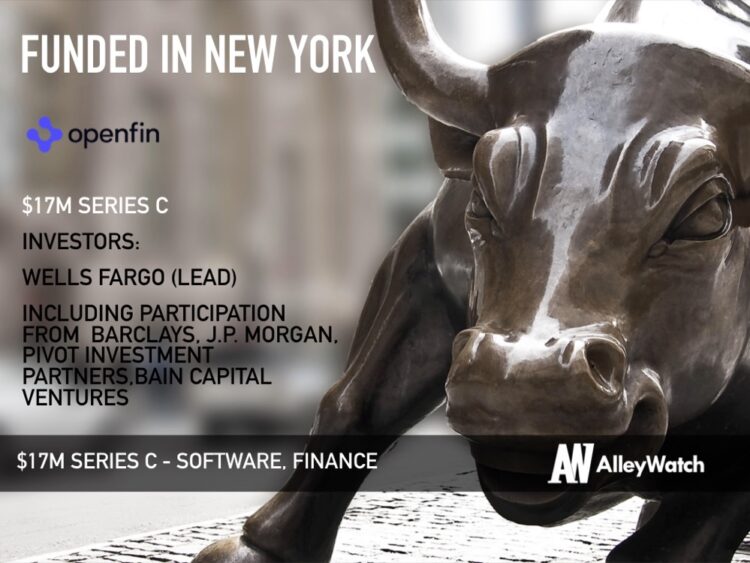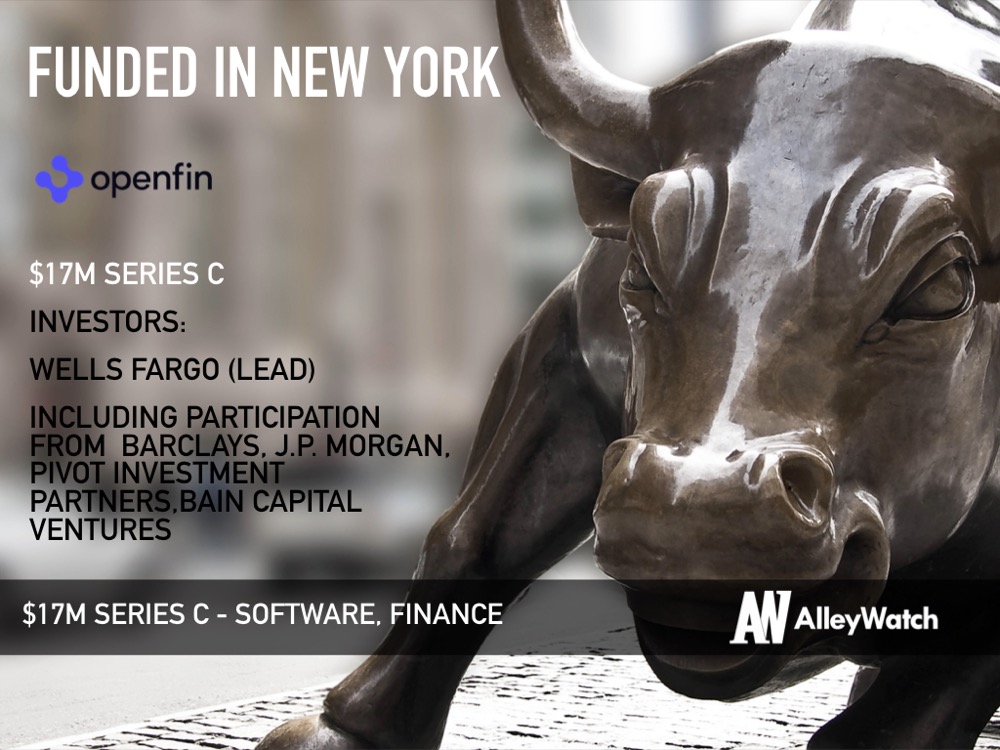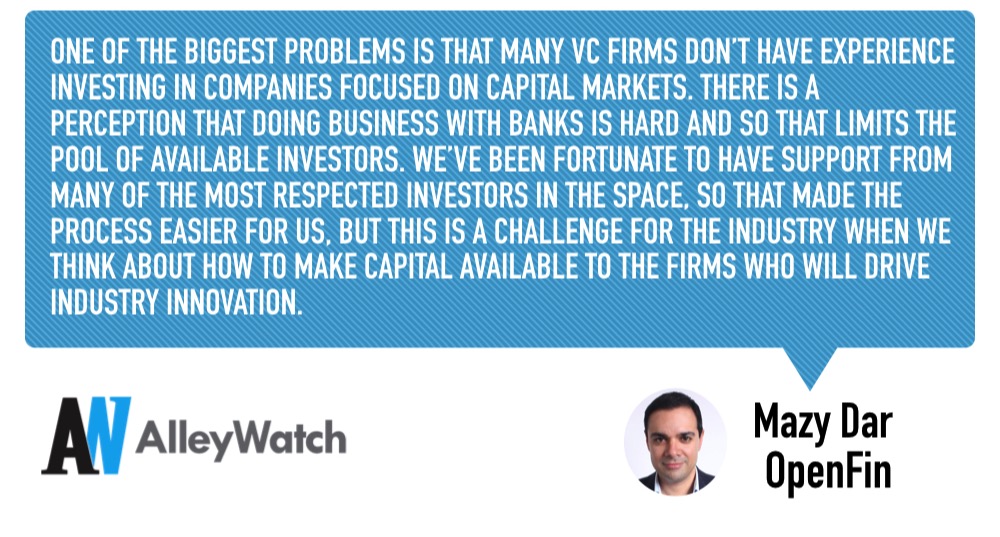A legacy platform refers to an old method or outdated computing system that may continue to impact the organization due to its important, historic role in managing and setting up business operations, causing an organization to constantly play catch-up and be very slow to integrate with the latest technologies. OpenFin, through its pioneering operating system for finance, enables banks and buy-side firms to integrate with the latest fintech apps without spending months worrying about traditional custom development. Adopted by 22 major banks and deployed on over 200,000 desktops, OpenFin makes the innovation cycle more efficient for the financial services industry.
AlleyWatch spoke with founder and CEO Mazy Dar about the company’s origin, future plans, and latest round of funding, which brings its total funding to $42M across seven rounds.
Who were your investors and how much did you raise?
This was our series C funding round. We raised $17M. The round was led by Wells Fargo, along with fellow new investor Barclays. Existing investors who participated include Bain Capital Ventures, J.P. Morgan, and Pivot Investment Partners.
Tell us about the product or service that OpenFin offers.
OpenFin is the operating system of finance. We solve two of the biggest problems banks and buy-side firms encounter: (1) how to speed app delivery and improve the innovation cycle and (2) how to get their legacy platforms to interoperate with the slick new fintech apps that are coming to market. Just as mobile app providers can instantly distribute their apps to users on iOS and Android phones and those apps can interoperate seamlessly, our operating system allows the same instant distribution and app interoperability on financial desktops.
What inspired you to start OpenFin?
When we worked at Creditex, my cofounder Chuck Doerr and I built a trading platform that we had to distribute onto desktops at all the largest banks in the world. We realized that this is an incredibly painful thing to do and involved something called “software packaging” which can literally take months or quarters for each bank.
We realized this was a problem for anyone who needs to deliver an app to an end user who sits at a bank or buy-side firm. With OpenFin, we saw an opportunity to solve the problem holistically for the entire industry.
Our focus on being open and collaborative across the industry is a key differentiator. It’s this openness that makes the OpenFin OS layer even more powerful and central to driving change on user desktops and accelerating digital transformation across the industry. Apps on the desktop are instantly modernized and become more integrated an interesting to users as they can work seamlessly together.
What market does OpenFin target and how big is it?
Our target client base extends across the capital markets, from the buy side to the sell side to third parties. We are being used by 22 major banks, 12 large asset managers and hedge funds and 40 of the leading vendors in the space. We are deployed on over 200,000 desktops across more than 1,500 buy- and sell-side firms in 60 countries.
What’s your business model?
We offer two versions of our operating system: Community and Enterprise. The former allows firms to run their apps with our OS for free, but it’s the latter that provides enterprise support and enables firms to upgrade their financial desktop at scale, and that accounts for most of our revenue. Recently, we announced preferential Enterprise pricing for startups to make it even easier for FinTechs to help drive digital transformation.
What was the funding process like?
We met with a wide variety of investors, and the shared vision and clear excitement for what we do led to deals with Wells Fargo and Barclays. In addition, the fact that existing investors put more of their money behind us is the ultimate validation.
What considerations did you have in raising a round led by strategic investors versus traditional venture investors?
In our industry, strategic partners are extremely important. They provide invaluable guidance in our mission to best serve the industry, and their participation catches the interest of others in the space. That said, we have an outstanding relationship with firms like Bain Capital Ventures and Pivot Investment Partners, and all parties were pleased with their roles in our prior funding rounds, so securing their participation was a natural choice as well.
What are the biggest challenges that you faced while raising capital?
One of the biggest problems is that many VC firms don’t have experience investing in companies focused on capital markets. There is a perception that doing business with banks is hard and so that limits the pool of available investors. We’ve been fortunate to have support from many of the most respected investors in the space, so that made the process easier for us, but this is a challenge for the industry when we think about how to make capital available to the firms who will drive industry innovation.
What factors about your business led your investors to write the check?
One of the biggest factors in this round was that we have hit critical mass with the user base from banks and buy-side to vendors. We are now seeing a significant network effect with banks and buy-side asking their vendors to build on OpenFin and buy-side asking banks to do the same. Everyone wants to invest in platforms with recurring revenue and network effects and we’ve now crossed that threshold.
What are the milestones you plan to achieve in the next six months?
We have a number of exciting initiatives in the works. We recently unveiled OpenFin Cloud Services, allowing our clients to build custom app stores for their employees. We also have a number of new partnerships to announce. The pace of digital transformation seems to accelerate every day, and we’re pleased to be at the forefront.
What advice can you offer companies in New York that do not have a fresh injection of capital in the bank?
Be relentless and never sell yourself short on your vision, especially if you know it’s a good one. This city is full of talented folks with big ideas and deep pockets. Put in the hours, work your network and you’ll find the right partner. And of course, don’t let that bank account get to zero.
Where do you see the company going now over the near term?
This funding round is about building scale. We want to drive digital transformation at speed across the industry in a collaborative manner, built on a foundation of openness, and this round will allow us to do exactly that.
What’s your favorite restaurant in the city?
Marc Forgione






